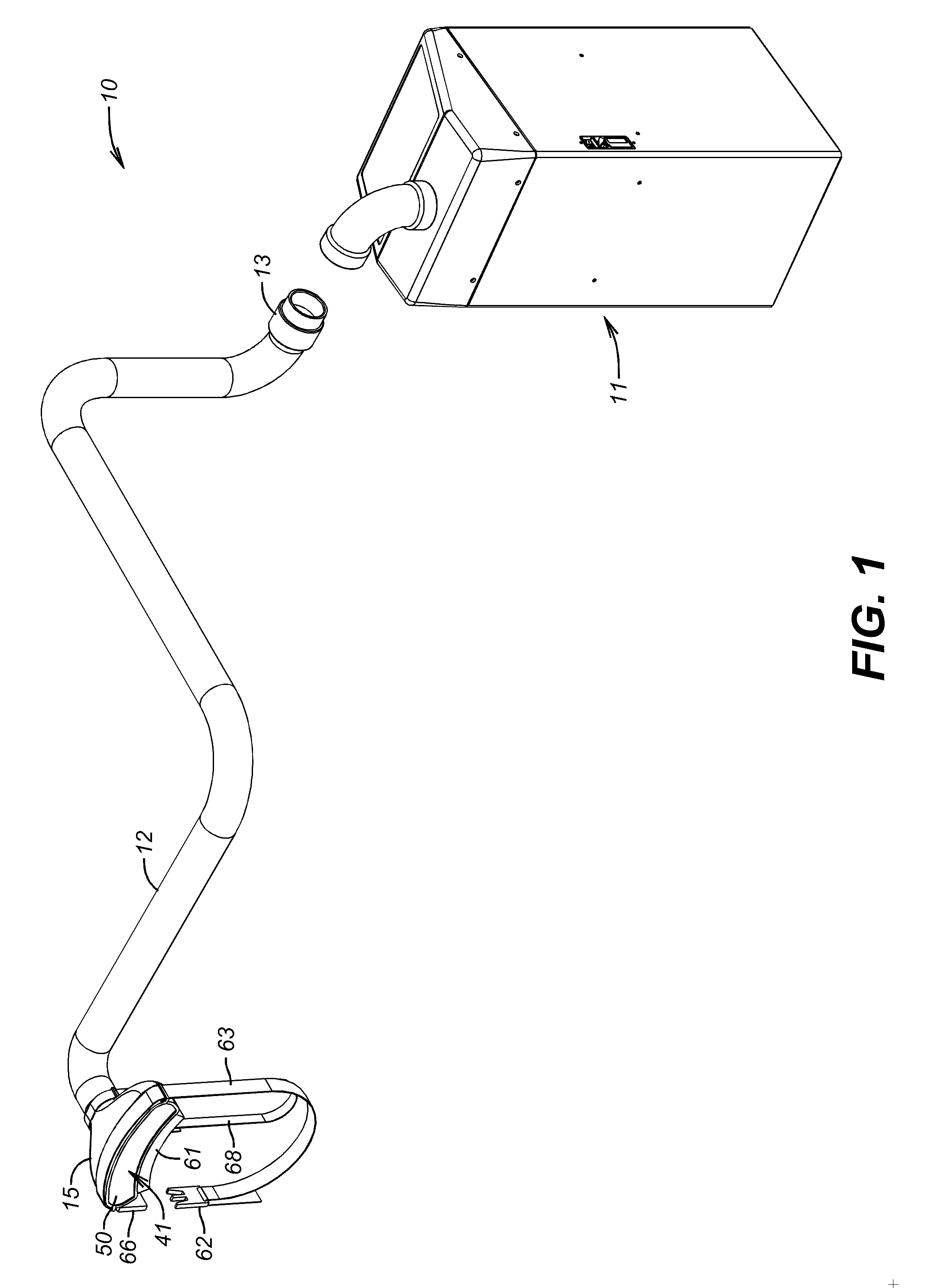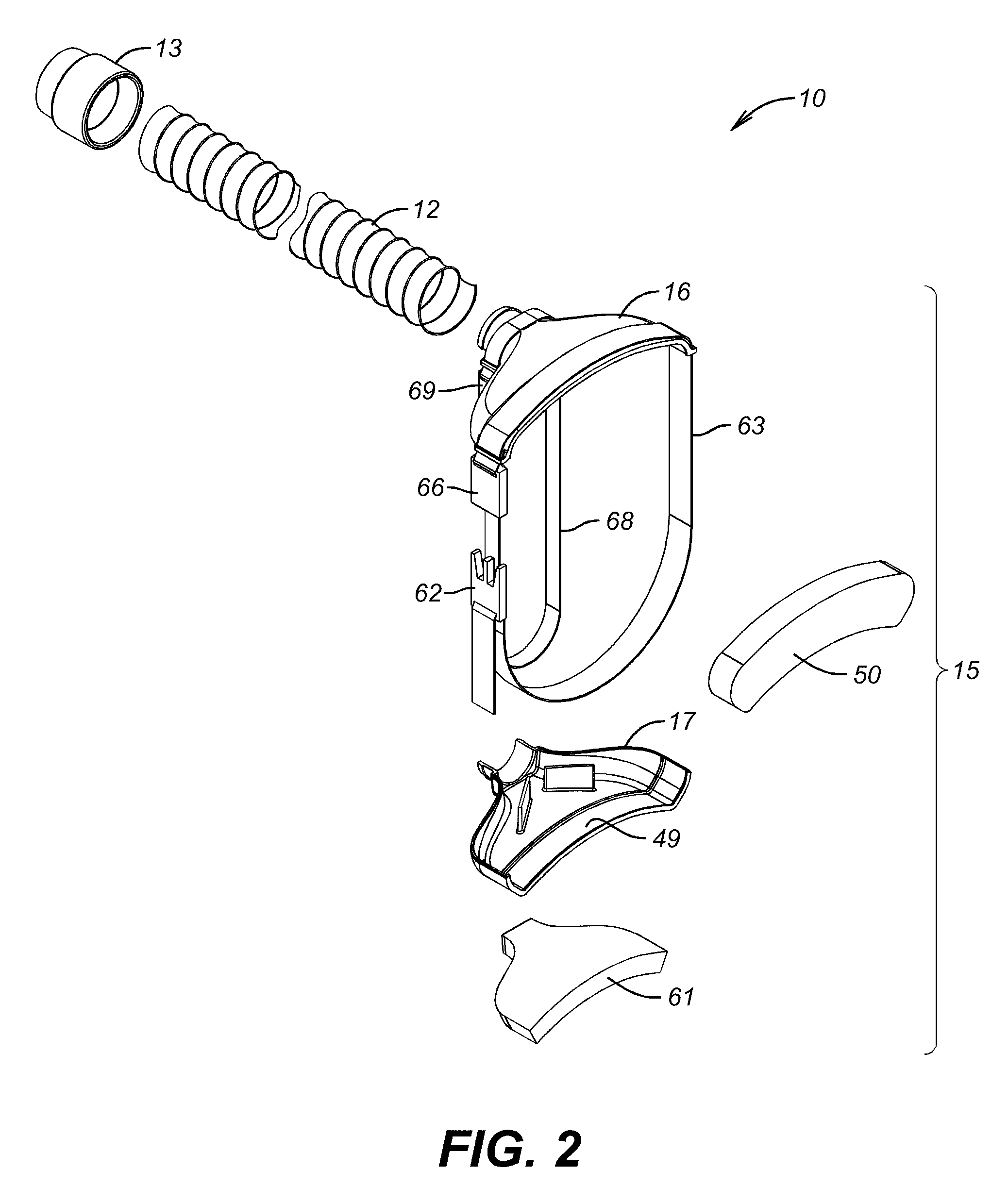Apparatus and Method for Reducing Contamination of Surgical Sites
a technology for surgical sites and masks, applied in the field of surgical instruments, can solve the problems of reducing the availability of hospital beds for other patients, dramatic increase in patient length of stay and cost, and hospital acquired infections (“hai”), so as to prevent bacterial invasion, the effect of being effective, inexpensive and easy to implemen
- Summary
- Abstract
- Description
- Claims
- Application Information
AI Technical Summary
Benefits of technology
Problems solved by technology
Method used
Image
Examples
example 1
FLOW SIMULATION EXAMPLE 1
Prior Art—Flow Not Horizontally Level with the Surface and Not Sterile.
[0099]Referring to FIGS. 17-19, a series of flow simulations are depicted that employ an emitter configuration of the type described in the article by Thore M, et al.: Further bacteriological evaluation of the TOUL mobile system delivering ultra-clean air over surgical patients and instruments, JOURNAL OF HOSPITAL INFECTION 63, 185-192 (2006), noted above as similar to U.S. Pat. No. 3,820,536, configured and deployed as described in that article and employing flow velocities described in that article. The emitter outlet size is 0.55 meters (21.654 inches) wide, 0.4 meters (13.638 inches) high and has a central airflow zone with a peripheral airflow zone 1.5 inches inset from the edges of the emitter. The peripheral zone is angled outwardly 25 degrees. The emitter is 0.681 meters (24.350 inches) above surface 102 and is inclined toward surface 102 at a 60-degree angle. The arcuate surface ...
examples 2-6
FLOW SIMULATION EXAMPLES 2-6
Introductory Comments
[0102]In Flow Simulation Examples 2-6 and corresponding FIGS. 20-34, the flow simulations used the same nominal emitter flow velocity (350 ft / min), so a higher series 135-139 of reference numerals indicative of higher flow velocities are employed in FIGS. 20-34 to supplement the convention of weighted solid lines and dashed lines for illustrating velocities. Nominal ranges of velocities for solid and dashed lines are indicated in FIGS. 20-34 by reference numbers as follows:
Reference numeralVelocity (ft / min.)135from about 280 to about 350136from about 220 to about 280137from about 140 to about 220138from about 80 to about 140139from about 20 to about 80
The same reference numeral is used for a given range of velocities whether the reference numeral leads to a solid line or a dashed line. Solid flow lines at a velocity of 135 have a heavier weight than solid flow lines at a velocity of 136, solid flow lines at a velocity of 136 have a he...
example 2
FLOW SIMULATION EXAMPLE 2
Prior Art—Coanda Jet Effect, Flow Horizontal But Not Sterile
[0103]Referring to FIGS. 20-22, a series of flow simulations are depicted that employ a rectilinear flat bottomed emitter 115 that is 8 inches wide and 0.5 inches high (the dimensions of the flat nozzles depicted in U.S. Pat. No. 4,275,719 to Mayer, mentioned above) over a flat plate 202, as in a Coanda Effect for a jet emitted adjacent a flat surface. A space of 0.375 above the flat plate was necessary for simulation stability. The simulations were performed using the same computer program as in Flow Simulation Example 1. The following parameters were used for the program simulations: velocity condition at emitter outlet (exiting emitter) was 350 ft / min; all other boundaries received P=0 (atmospheric) conditions. Mesh size was 16″ wide, 12″ tall and 24″ long. The simulation contained 190,490 fluid elements and converged after 904 iterations
[0104]FIG. 20 is an isometric depiction of the flow trace e...
PUM
 Login to View More
Login to View More Abstract
Description
Claims
Application Information
 Login to View More
Login to View More - R&D
- Intellectual Property
- Life Sciences
- Materials
- Tech Scout
- Unparalleled Data Quality
- Higher Quality Content
- 60% Fewer Hallucinations
Browse by: Latest US Patents, China's latest patents, Technical Efficacy Thesaurus, Application Domain, Technology Topic, Popular Technical Reports.
© 2025 PatSnap. All rights reserved.Legal|Privacy policy|Modern Slavery Act Transparency Statement|Sitemap|About US| Contact US: help@patsnap.com



